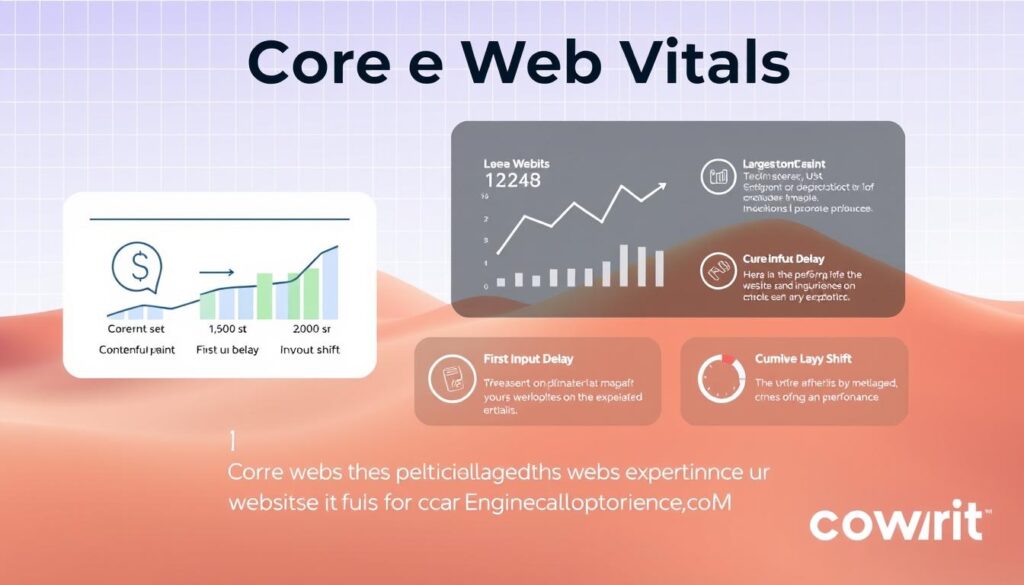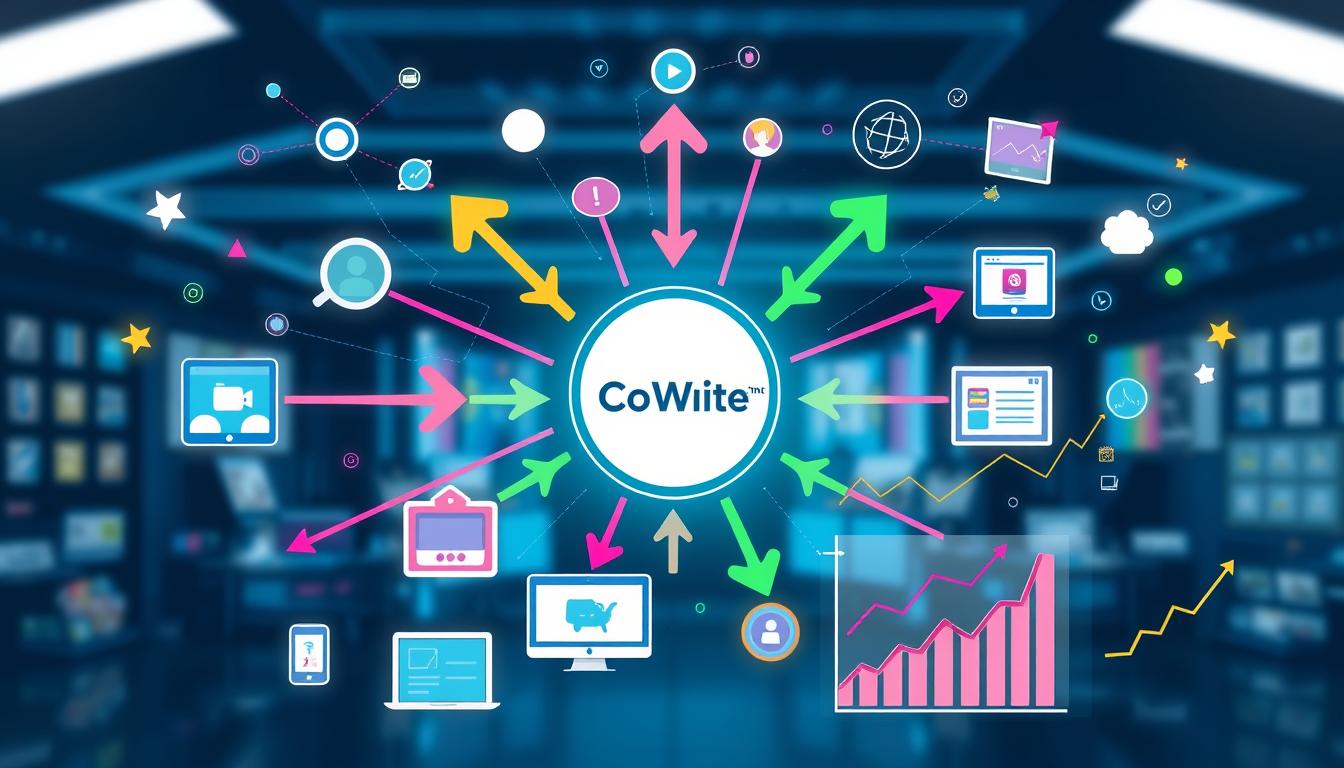If you write content or work in SEO, knowing about Google algorithm changes is key. Google’s algorithms are complex. They decide how relevant and ranked web pages are in search results.
To do well in SEO, you must keep up with the latest. Learning about Google’s algorithms and updates helps. This way, you can make your website more visible and ranked higher. Looking for a Content Writing Team? Connect with us via WhatsApp Call or Chat at +44-7822-010953 or +44-7874-424345 (USA Support Available).
Key Takeaways
- Google’s algorithms determine the relevance and ranking of web pages.
- Staying updated with algorithm changes is vital for SEO.
- Understanding major updates can help refine SEO strategies.
- Optimizing SEO efforts can improve website visibility.
- A well-informed content writing team can help you stay competitive.
The Importance of Google Algorithms in SEO
Knowing about Google’s algorithms is key for better website visibility. These algorithms look at content quality, user experience, and website authority. They rank websites based on these factors.
What Are Google Algorithms?
Google algorithms are complex systems that find data and show the best results for a search. They check many things, like:
- Content relevance and quality
- User experience and engagement metrics
- Website authority and trustworthiness
- Technical SEO aspects like page speed and mobile-friendliness
These factors help Google show the most relevant and useful content. This makes SEO optimization through Google algorithms very important for digital marketing.
How They Impact Search Rankings
Google algorithms greatly affect how visible your website is. By understanding and adapting to these algorithms, you can improve your SEO. This can bring more visitors to your site.
Some key ways Google algorithms impact search rankings include:
- Prioritizing high-quality, relevant content
- Penalizing websites with poor user experience or manipulative tactics
- Rewarding websites with strong authority and trust signals
By focusing on these areas and aligning your SEO strategy with Google’s algorithmic preferences, you can boost your website’s ranking. This improves your online presence.
Major Google Algorithm Updates
To stay ahead in SEO, it’s key to know about Google’s big algorithm updates. These updates have changed how websites rank and content is optimized for search engines.
Panda Update: Quality Content Matters
The Panda update started in 2011. It aimed to improve the quality of content in search results. It penalized sites with thin, duplicate, or low-quality content.
This update showed how important it is to have unique, valuable, and user-centric content. To follow Panda, make sure your content is well-researched and engaging. It should meet your audience’s needs.

Penguin Update: Link Building Strategies
The Penguin update came in 2012. It targeted manipulative link-building practices, aiming to cut down on spam in search results. Penguin pushed for white-hat link building strategies.
This means earning links through quality content and real outreach. To meet Penguin, focus on quality links over quantity.
Hummingbird Update: Understanding User Intent
The Hummingbird update was in 2013. It changed how Google understands search queries. Hummingbird made search results more accurate and relevant.
This update showed the need for content that matches what users are searching for.
BERT Update: The Role of Natural Language Processing
The BERT update was in 2018. It improved Google’s understanding of natural language with NLP. BERT made search results more precise.
To benefit from BERT, create content that naturally answers user questions and needs.
By understanding and adapting to these major Google algorithm updates, you can improve your SEO. This will help your website show up better in search results.
Core Web Vitals and SEO
To stay ahead in search rankings, it’s key to understand and improve Core Web Vitals. These metrics measure how well your site works for users, focusing on speed, how it responds, and visual stability. By making these areas better, you can boost your site’s user experience and search rankings.
What Are Core Web Vitals?
Core Web Vitals are special metrics by Google to check your site’s user experience. They include:
- Largest Contentful Paint (LCP): This measures how fast your page loads. To make LCP better, make sure your page loads quickly by optimizing images and using browser caching.
- First Input Delay (FID): This checks how interactive your page is. To improve FID, reduce JavaScript’s impact on your page’s interactivity.
- Cumulative Layout Shift (CLS): This looks at visual stability. To better CLS, make sure elements on your page don’t move unexpectedly as it loads.

Why They Matter for Google Ranking
Google’s updates have made user experience more important, making Core Web Vitals key for rankings. By improving these metrics, you’re not just making your site better for users. You’re also meeting Google’s ranking standards. This is vital for leveraging Google algorithms for SEO success.
Websites that do well on Core Web Vitals tend to rank higher. They offer a better user experience, which can increase visibility and engagement.
How to Optimize Your Site for Core Web Vitals
Improving your site requires a focus on speed, responsiveness, and visual stability. Here are some tips:
- Optimize Images: Compress images to make them smaller, which speeds up page loading.
- Minify CSS and JavaScript: Make your CSS and JavaScript files smaller to speed up loading.
- Leverage Browser Caching: Store often-used resources locally in the browser to avoid repeat downloads.
- Avoid Unexpected Layout Shifts: Keep your website’s layout stable and avoid sudden changes as content loads.
By using these strategies, you can greatly improve your site’s performance on Core Web Vitals. This will help your SEO optimization through Google algorithms. Keep an eye on your site’s performance and make adjustments as needed.
Understanding Search Intent
Knowing what users want is key to making content they’ll love. By matching your content with what users expect, you can make it more relevant and valuable. This leads to better rankings and more people engaging with your site.
Types of Search Intent
Search intent is why someone searches for something. It can be informational, navigational, or transactional. Knowing these types helps you create content that really meets user needs.
- Informational intent: The user wants to learn about a topic.
- Navigational intent: They’re looking for a specific website or page.
- Transactional intent: They plan to buy something or take action.
Aligning Content with User Expectations
To match your content with what users want, you must know what they’re looking for. This means studying how they behave, finding the right keywords, and making content that fulfills their needs.
| Content Type | User Expectation | SEO Benefit |
|---|---|---|
| Informational | In-depth information on a topic | Increased authority and trust |
| Navigational | Easy navigation to a specific page | Improved user experience |
| Transactional | Clear calls-to-action | Higher conversion rates |
By understanding search intent and aligning your content, you can improve your search engine rankings. This brings more relevant visitors to your site.
Technical SEO and Algorithm Compliance
Google’s algorithms keep changing, making technical SEO more important for better search rankings. Technical SEO makes your website easy for search engines to find and index. This helps your site rank higher and attract more visitors.
Key Elements of Technical SEO
Several key elements are vital for effective technical SEO. These include:
- Page Speed: Your website should load fast. Slow sites can lead to more people leaving and lower rankings.
- Mobile Responsiveness: Most searches are on mobiles. A site that works well on mobiles is key for good rankings and user experience.
- SSL Encryption: An SSL certificate is now a ranking factor. It keeps your site secure and protects user data.
- XML Sitemaps: An XML sitemap helps search engines understand your site’s structure. This makes it easier for them to crawl and index your pages.

The Role of Structured Data
Structured data, or schema markup, is key in technical SEO. It helps search engines understand your web pages better. By adding schema markup, you can make your search listings more attractive with rich snippets. This can lead to more people clicking on your site and visiting it.
Common Technical SEO Issues
Common technical SEO issues include:
- Duplicate Content: Having the same content in different places can confuse search engines and hurt your ranking.
- Broken Links: Broken links can make your site hard to use and hurt your rankings.
- Crawl Errors: Crawl errors can stop search engines from finding your content. This reduces your site’s visibility.
Fixing these technical SEO problems is essential. It helps your website stay up to date with Google’s algorithm changes. This keeps your site competitive in search rankings.
On-Page SEO Best Practices
Good on-page SEO can really help your website get seen more and get more visitors. By making each page better, you can climb up in search rankings and make your site easier to use.
Importance of Title Tags and Meta Descriptions
Title tags and meta descriptions are key for on-page SEO. Title tags tell search engines what your page is about. Meta descriptions give a quick summary of your content. Making these better can help more people click on your page and improve your search rankings.
- Use descriptive and keyword-rich title tags.
- Write compelling meta descriptions that include your target keywords.
- Ensure title tags are under 60 characters and meta descriptions are under 160 characters.
Optimizing Header Tags for SEO
Header tags (H1, H2, H3, etc.) are important for organizing your content and highlighting key words. Using them right can make your content easier to read and better for SEO.
- Use H1 tags for the main title of your page.
- Utilize H2 and H3 tags to break up your content into sections.
- Include target keywords in your header tags where relevant.
Effective Use of Keywords
Keywords are the heart of SEO. Using them well can boost your search rankings. But, it’s important to use keywords naturally and avoid keyword stuffing.
| Keyword Strategy | Description | Best Practice |
|---|---|---|
| Keyword Research | Find the right keywords for your content. | Use tools like Google Keyword Planner. |
| Keyword Placement | Put keywords in title tags, meta descriptions, and headers. | Make sure keywords are used naturally in your content. |
| Keyword Density | Keep keyword density at up to 2%. | Avoid stuffing keywords by using synonyms and related terms. |

By following these on-page SEO tips, you can make your website more visible, attract more visitors, and boost your SEO. Remember, SEO is a continuous effort that needs regular checks and tweaks.
Off-Page SEO Strategies
Off-page SEO is key to your SEO plan. It affects your site’s authority and ranking. By working on external signals like backlinks and social signals, you can make your site more visible and credible.
Building Authority through Backlinks
Backlinks are important for Google to see your site’s authority. High-quality backlinks from reputable sites can help your ranking. But, bad links can hurt it. To get good backlinks, make content that others want to link to.
Here are some ways to get quality backlinks:
- Guest blog on sites with high authority
- Join industry forums and discussions
- Make content that others find useful
| Backlink Type | Description | Impact on SEO |
|---|---|---|
| Editorial Links | Links from reputable sites that reference your content | High |
| Resource Links | Links from sites that list valuable resources | Medium to High |
| Guest Blogging Links | Links from articles written for other websites | Medium |
Social Signals and Their Impact on SEO
Social signals, like likes and shares, can also affect your ranking. The exact impact is debated, but they can bring more traffic and visibility. This can lead to more backlinks.
To use social signals well, make content that people want to share. This can include:
- Blog posts that answer common questions
- Visual content like infographics or videos
- Promotions or contests to get people involved

By using these off-page SEO strategies, you can boost your site’s authority. This can lead to more traffic and success in SEO.
Local SEO and Google Algorithms
To attract local customers, you need to keep up with Google’s algorithm changes. Local SEO means making your website show up in local searches. This is done by using local listings and keywords.
The Importance of Local Listings
Local listings are key for local SEO. They help your business show up in local searches. This makes it easier for customers to find you. Claiming and optimizing your Google My Business listing is a top way to boost your local search visibility.
To make your local listing better, keep your business name, address, and phone number (NAP) the same everywhere. Add good photos and answer customer reviews quickly.
Strategies for Local SEO Optimization
Good local SEO needs a few key steps. Here are some important strategies:
- Use location-based keywords in your website content and meta tags.
- Create content that is relevant to your local audience.
- Build high-quality backlinks from local websites.
- Optimize your website for mobile devices, as many local searches occur on smartphones.
Here’s a comparison of key local SEO strategies and their impact:
| Strategy | Impact on Local SEO | Implementation Difficulty |
|---|---|---|
| Optimizing Google My Business | High | Easy |
| Using Location-Based Keywords | Medium | Medium |
| Building Local Backlinks | High | Hard |
| Creating Local Content | Medium | Medium |
By using these strategies and keeping up with Google’s changes, you can boost your local SEO. This will help attract more customers to your business.
The Future of Google Algorithms
Google is always changing, and knowing its algorithms is key for SEO success. The future of Google’s algorithms will likely be influenced by new trends like AI and machine learning. These technologies are already helping Google understand what users want and give better search results.
Emerging Trends in Algorithm Updates
Google’s algorithms are getting smarter, thanks to AI and machine learning. These tools help Google understand what users are looking for. Some new trends include:
- Enhanced natural language processing (NLP) capabilities
- Increased use of machine learning to predict user behavior
- Better handling of complex search queries
By keeping up with these trends, you can improve your SEO strategy and stay ahead.
The Role of AI in SEO
AI is changing how Google’s algorithms work. With AI, Google can process huge amounts of data quickly and make smarter decisions about search rankings. Here’s how AI is affecting SEO:
| AI Application | Impact on SEO |
|---|---|
| Improved search query understanding | Better matching of search results to user intent |
| Enhanced content analysis | More accurate assessment of content quality |
| Predictive analytics | Anticipating user behavior and adjusting rankings |
Understanding AI’s role in SEO helps you create content that meets Google’s changing standards.
To stay ahead, keep up with Google’s algorithm updates and adjust your SEO strategy. This way, you can attract more visitors and keep your site competitive.
Measuring and Analyzing SEO Results
Measuring and analyzing SEO results helps you improve your search engine optimization. Understanding Google algorithms’ impact on your website is key. This knowledge guides your decisions to boost your online presence.
Tools for Tracking Algorithm Impact
To measure SEO results, use tools that track Google algorithms’ effects. Google Analytics and Google Search Console are vital for insights into your website’s performance.
Google Analytics shows how users interact with your site. It tracks page views, bounce rates, and conversion rates. This data helps you spot areas for improvement and tweak your SEO strategy.
Google Search Console offers data on your site’s search result performance. It includes impressions, clicks, and average position. This info helps you see how Google algorithms affect your site’s visibility.
Adjusting Strategies Based on Data
After gathering data from Google Analytics and Search Console, adjust your SEO strategies. This might mean refining keywords, improving content, or boosting technical SEO.
If a page isn’t doing well in search results, revisit your content optimization strategy. This could make it more relevant and ranked higher.
By always monitoring your SEO results and tweaking your strategies, you can increase your website’s visibility. This leads to more traffic and helps you reach your online goals.
Staying Updated on Google Algorithm Changes
Google keeps improving its algorithms, and knowing about these changes is vital. This knowledge helps you stay ahead in SEO. To do this, you need to use the right tools and follow best practices for keeping up with updates.
Resources for Ongoing Learning
There are many ways to stay informed about Google’s algorithm updates. Top resources include Search Engine Journal and Moz. Also, don’t miss out on SEO and digital marketing conferences and webinars. And, of course, keep an eye on Google’s official announcements and webmaster guidelines.
- Industry-leading blogs
- Conferences and webinars
- Google’s official announcements
These sources offer deep insights into new algorithm updates. They help you understand how these changes affect your SEO strategy. This way, you can maximize your SEO efforts.
Best Practices for Monitoring Updates
To keep track of Google’s algorithm updates, follow these tips: Check Google’s official channels often for news. Use tools like Google Search Console to watch your site’s performance. Also, connect with the SEO community to share and learn from others.
- Regularly check Google’s official channels
- Use tools like Google Search Console
- Stay engaged with the SEO community
By following these steps, you can stay on top of changes. This ensures your SEO strategy is always up-to-date. You’ll be using Google’s algorithm knowledge to its fullest.
Looking for a Content Writing Team?
To get better search rankings, it’s key to know how to use Google algorithms. Focus on the factors that Google looks for to make your site more visible. This will help more people find your website.
Having trouble writing content that people like and search engines rank high? Think about working with a professional content writing team. For more tips on SEO writing, check out this detailed guide on SEO writing best practices.
Boost Your SEO Efforts
Our team of skilled writers and SEO experts can craft a content plan that meets Google’s latest updates. This will boost your online presence.
Get in Touch
Want to learn more about our services? Reach out to us on WhatsApp Call or Chat at +44-7822-010953 or +44-7874-424345. We offer support in the USA too. Let’s talk about how we can help you succeed with SEO by using Google algorithms.



